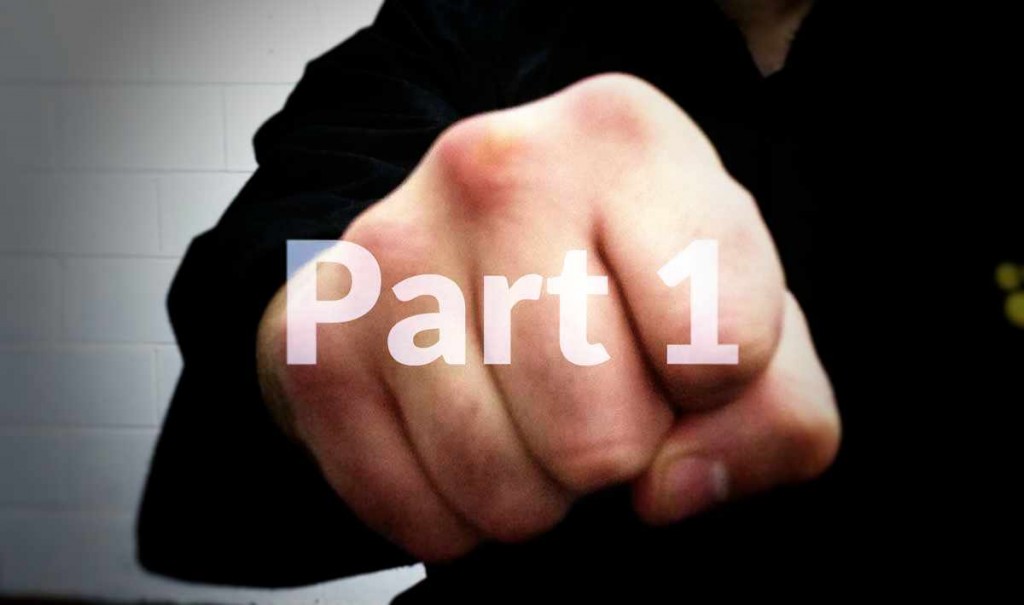Body Mechanics 1 – Basics of The Reverse Punch! Part 1

Over the next year I am going to write a series of blogs on applying accurate body mechanics to common techniques that pop up in oriental fighting arts. These articles will only go over some very basic key points; some of you may go down the checklists and say ‘so what’ and ‘of course’. If you are one of these people then well done! You’re probably getting (or got) good instruction in the basics and have no need of these articles.
However, one of my hobbies when travelling is to pop in martial arts classes and have a watch – sometimes you learn great things and meet some really skilled people but sadly an awful lot of ‘traditional’ instructors are teaching the basics shockingly wrong! Sadly this leads to students thinking (rightly in these cases) the traditional methods don’t work. Sometimes seeing these guys (and gals) teach it feels like a nuclear lab has been left to a troop of chimps. Not only is the method they are training generating vastly substandard skills but also leaving the students open to chronic injuries through the long term misuse of their body. Solo training should be all about understanding how our bodies are designed to work and optimising our structure.
I decided to start this series with the reverse punch (Ping Choi, level punch) as most Kung Fu, Karate and Taekwondo schools teach this technique from day one. This is your classic, quintessential ‘Karate’ punch where the one hand goes forward turning over so the knuckles are on top whilst the other pulls back to the hips with the fist palm up. Whilst this basic reverse punch seems simple it is in fact a multi-layered exercise and takes a great deal of patience and feeling to develop. Indeed the father of Japanese Karate, Gichin Funakoshi, only weeks before his death in his 89th year was supposed to have told one of his students he thought he’d finally got the technique right. Clearly there is a lot more going on then you put your left arm in, your right arm out (oo o the oki koki!).
Of course styles may vary on a few aspects but fundamentally human movement does not and certain errors are always errors. If you’ve been practising for a while and realise that you make a few of these mistakes, or worse still so does your teacher, it may be time to move on. I have tried to cover some key areas in this article but there is easily a whole book in doing this punch ‘right’. For people who find this article a little heavy going I have highlighted major errors in red so you can skim through and see if you are making any of them.
Overall feel and principles
Do not lock joints out! Do not over use arm muscles!
People often ‘feel’ they have a good punch whilst what they actually do is either tense up their muscles on striking or lock the elbow out or both. This enables them to feel the power of their punch as they are, in essence, hitting themselves. A good maxim is: where you feel force is where it is stopping not where it is starting. A good punch feels like nothing to the puncher and everything to the punchee (‘Boxing is like snapping the fingers’). Force should travel through the whole body smoothly and evenly and not feel localised in any one place, a natural release of force like slamming a car door.
Once you have it there are ways to test it to check its power but your subjective feeling that it is strong often leads you in completely the wrong direction. Training this punch is also different to how it is usually used in combat as you are essentially moving through a maximum range of motion in order to instil a good understanding of power generation along one line. In combat you will use a small ‘portion’ of the punch. Understanding this is important as if you wish to be able to use this punch from guard then your hand must lie on this line so it is ready to fire. Even arts which don’t contain a full Ping Choi tend to contain parts of it (Taiji parry and punch, XingYiQuan’s crushing fist) and rather then practising highly abstracted methods to develop ‘reeling of the silk’ or whole body power it may be more usable and direct to incorporate such basics. Systems which stress parts of this line would do well to re-incorporate its training. If you can’t generate huge force from the full motion it will be impossible to generate it in a smaller segment.
Of course, over time more advanced aspects like specialist breathing and methods for activating more soft tissue to add power to the punch are useful, but without accurate basics they will do little good and tend towards navel gazing.
Read Body Mechanics 1 – Basics of The Reverse Punch! Part 2
Chris

Responses